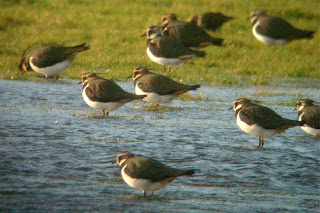 |
| Pink-footed geese |
Unfortunately some loud, heavy duty log chopping was going on along the tideline so the bulk of the birds were staying firmly on the western side of the Lune. Even at considerable range it was clear that there were at least 500 geese in the fields alongside Heaton Marsh.
During my visit a couple of further skeins came through. The first group contained around 200 birds, and carried on in a southwesterly direction. The second flock, of approximately 100, dropped onto Aldcliffe Marsh.
I doubt I'm going to get much opportunity to 'scope through any Aldcliffe geese in the next couple of weeks as I'll be out of the area, but hopefully someone will get chance to search though for something interesting!
Pinkfeet generally pass though in variable, but usually significant, numbers right through into spring so there's plenty of time for a stray bean goose or a party of white-fronted geese to drop in.
 |
| Wildfowlers' Pools |
The familiar boundaries of the Wildfowlers' Pools too have disappeared as the pools have become part of the flooded field. On the plus side, a single black-tailed godwit was feeding there yesterday.
The Flood, of course, is currently more like a lake and does its best to attract lots of curlew, lapwing, redshank and black-headed and common gulls, especially over high tide.
 |
| A bit of glamour... |
Of note, a kingfisher was on the canal by Whitecross in central Lancaster yesterday. Almost everyone in the RSPB office nipped out to year-tick it as it sat quietly digesting a small fish in the overhanging canalside vegetation.





